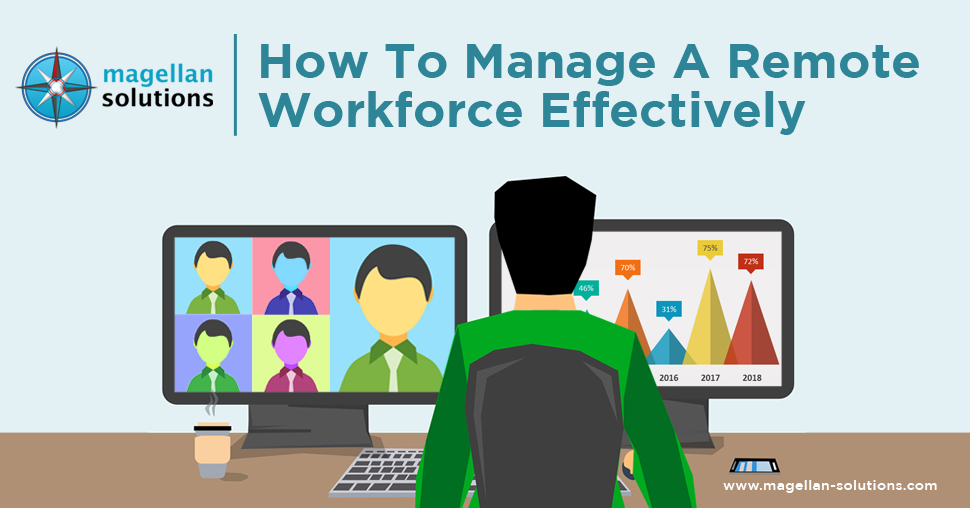Schedule a FREE call with our outsourcing expert now and get a precise quotation that meets your requirements. Don't wait - get started today!
To contain the spread of the coronavirus (COVID-19) pandemic and to protect their employees from catching the disease, many business owners are now having difficulties managing a remote workforce. Though remote work has been up for many years now, and the trend has been going around for decades, it is only these days that most business executives have explored its possibility. However, transitioning to this working style is not always smooth sailing, especially for first-timers.
This article covers:
What is Remote Work?
Remote work refers to a working arrangement that doesn’t require professionals to come into an office. A remote employee can do the job at home, in a co-working space, at a café, in the countryside, by the beach, or in any place other than a traditional office.
This working style enables the business to hire talents from different geographical regions. Employees can work flexible hours — giving them greater freedom. Compared to the traditional on-site arrangement which relies greatly on hours rendered, remote work measures productivity based on completed projects within the allowable time frame.
Before implementing remote work, there are some concerns you would need to address first:
- Which functions can be done remotely and which are not? Some roles require staff to report directly to the office.
- How is managing a remote workforce like? How will you stay in touch and keep the team engaged?
- What are the traits and skills will you look for in a remote employee when hiring one? How will you train and motivate your in-house employees who will transition into a work-from-home setup? What should they expect from you? It is important to lay down all your expectations right from the start.
The Difference Between Remote Work, On-Site Work, and Telecommuting
There are minimal differences between the three working styles. There are still deadlines, time-ins and time-outs, goals, metrics, and meetings. The huge difference lies in the methods used in running a project.
Remote work vs. On-site work
Remote work requires several tools and software to carry out projects efficiently. While on-site employees go to a conference room to talk about projects and accomplishments, remote employees do it through videoconferencing.
Working alone, without the direct supervision of a manager or a team leader, also requires independence and motivation. This is why professionals who strive the most in this setup are self-starters.
Remote work vs. Telecommuting
These two terms are often used interchangeably but there are some slight differences between them.
Remote work is as it is: working remotely. An managing a remote workforce entails employees don’t need to report to the office at all. This arrangement makes it possible to have a team member living in Asia as the other one comes from Europe.
Meanwhile, telecommuting may still require an employee to go to the office every once in a while. Most telecommuting roles prefer those who live within or close to the company’s geographical location.
Benefits of the Remote Work Arrangement
Sure, going remote is the future. But what can you gain from it? Is it worth it to invest in additional tools and software? Why do you even need a remote team?
To clear your doubts, read on the benefits you can get from this work arrangement.
Generate savings
So, it’s a yes. Offering remote positions slash overhead costs. At first, you may need to invest in tools, software, and training. This means shelling out some cash before you get started. But in the long run, you can save more than you spend by paying lower rent and utility bills. And why would you need additional office space which costs thousands of dollars when your employees are at home, working?
From the employees’ perspective, they can save money (and energy!) from commuting and lunch outs. It’s a win-win scenario for both parties.
Boost productivity
Most people work best within their territories. Add to that the fewer distractions at home, you can expect improved productivity and better output.In this survey, 77% say they are more productive when working remotely and 23% are even willing to work longer so they could accomplish more. As this study shows, 76% of people don’t like to be in their offices when working on an important project.
The constant activities in an office environment, including the little chit-chats from colleagues, makes it difficult to concentrate on a task. On average, it would take 26 minutes to regain focus after getting distracted.
Working from home can also improve the quality of life. With less stress from the daily commute and office politics, employees can gain a better work-life balance, significantly reducing the number of sick days.
Employees working on highly complex jobs and detailed tasks like graphic designers, data analysts, and writers tend to deliver better work in a remote setup.
Add more profit to your bottom line
This is simple math. Because profit equals revenue minus costs, going remote allows you to bring in more profit to your organization. You can secure a steadier bottom-line growth as you decrease the money spent on your overhead expenses.
Based on figures, businesses can save up to $11,000 per year for every half-time telecommuter. To give you a more concrete example, this report revealed that this work arrangement helped IBM to save $50 million on real estate costs while McKesson saved $2 million every year.
Attract and keep great employees
Offering a remote work option improves employee retention. According to this comprehensive report, 74% of employees will less likely leave their current company if there’s a remote work opportunity. Additionally, 99% of people would choose this working style for the rest of their careers.
The demands of this generation are different from those who came before them. While most boomers are content in going to and from the office, the majority of millennials desire the freedom to go wherever they want while keeping their jobs.
Moreover, in case one of your talented staff needs to move due to personal reasons, it is easier to keep him or her when you offer the work-from-home option.

Better business continuity
Like the COVID-19 pandemic, any calamities can affect businesses at any given moment. And without warning.With a remote team in place, you’ll only need to make little adjustments to your daily operations. You’re a step ahead — focusing your efforts more on how to deal with uncertainties rather than relocating your team to their houses.
Are You Managing a Remote Workforce?
The performance of your team has a direct correlation to your performance as a leader. Their productivity and efficiency depend on the way you oversee them. As John Rockefeller, an American business magnate puts it, “Good management consists of showing average people how to do the work of superior people.”
The following ideas will guide you on how managing a remote workforce can be done effectively.
Set clear expectations and KPIs
Be straightforward in laying out the tasks your team members need to accomplish. Set realistic deadlines and coherent metrics. Seek their opinions and suggestions as well. It is important to communicate with your team whatever expectations you have right at the beginning to prevent misunderstanding in the future.
Develop a communication strategy
Explore different options to keep your communication lines open. For quick discussions, questions, or clarifications, you can use instant messaging apps like Slack and Hangouts. For video conferencing, there’s Zoom and Skype. Schedule weekly virtual meetings to talk about your progress, plans, and other work-related and personal matters. If you (or any of your team members) are the type of person who needs full concentration to get things done, tell your team when they can best reach out to you.
Use proper communication to clear doubts and develop better working relationships with your staff.
Engage regularly
To keep your remote team motivated, here’s a rule: don’t leave them wondering how they’re doing. As their supervisor, it is your responsibility to guide them along the way. Constantly (but not intrusively) check on their progress at work. Ask them if they are experiencing difficulties and find out what you can do to support them.
Use reliable tools
Investing in reliable tools is basic knowledge in implementing a work-from-home arrangement. It makes collaboration possible despite the distance that separates you and your team. You can begin even with a limited budget since many apps today offer free plans. The key is to find out which works best for you.
Focus on goals
It is important to keep track of time. However, it is more valuable to measure your remote employees’ performance based on their accomplishments. As long as they’re fulfilling their tasks and meeting the goals you have set, all is going well. Don’t worry too much about their detailed activities, especially if you see that they’re delivering quality outputs.
Watch out for data privacy and security
When you’re handling sensitive data, be wary of using third-party tools and transferring information. Information leakage is most probable in this setup. Request to your IT department for assistance in connecting your team’s computers to a Virtual Private Network (VPN). This way, you can access your workstations securely through the Remote Desktop Protocol (RDP).
Build trust
Trust your team so they can trust you in return. When you set clear expectations and define their tasks, believe that they will comply. Lead by example to create a better mental image of how they should perform. Also, be available to them every time they need your help in finishing their task. Leaders who go out of their way to support their team prove themselves to be trustworthy.
Individualize
Bring out the strengths of each individual in your team by looking at them using a unique perspective. While some of your members enjoy remote work, others feel isolated and drained. Some are self-motivated, others need a little push to do their jobs. Be familiar with the way your staff behaves. Coach him or her using the approach recalibrated to fit him or her. This will let your staff feel important and be cared for as a person.
Coach and train your team
Constant growth and improvement are necessary for most employees, remote or on-site. If they deem their roles in your company as dead-end jobs, they become demotivated. Set aside time to train your team about what they still need to know about their roles, your business, or even the industry. Even remotely, you can make it fun by adding some exercises or ice breakers.
Connect your vision with their goals
Millennials don’t simply work for money. They do it to get closer to their goals and aspirations in life. Many of those who prefer a remote working style come from this generation, believing that there’s more to life than sitting up all day in front of a computer. It is critical to align their goals with your mission and values. Point out their impact on the organization. This will keep them motivated to work with you longer and more productively.
Offer emotional support
As mentioned, some employees are not well-suited in working remotely. But because they suddenly had to, they may feel isolated. Loneliness brings down productivity and performance. Surely, this isn’t good for the business.
Listen to the struggles of your team members and empathize with them. If you know where they’re coming from, you can come up with ways to help them get through this crisis and bring them back on track.
Maintain close connections
Maximize technology to establish or maintain close bonds with your team. Interact with one another socially. Lighten up the atmosphere by having informal conversations about anything other than work.
Managing A Remote Workforce’s Common Challenges
Lack of direct supervision
Employers are hesitant with remote work because of the fear of getting less work done. Without direct oversight, managers worry that their team might slack off and affect productivity. Employees, on the other hand, may struggle in communicating with their supervisors. To address this issue, both parties should maintain regular communication. Set a block of time for videoconferencing to discuss all concerns and expectations.
Keeping the team engaged
Without the usual setup and typical managerial support, the team may lose their motivation in getting their jobs done. Add to that the feelings of social isolation and loss of relevance. If this happens, productivity may suffer. Keeping the team engaged and motivated results in better performance and project delivery. Now and then, ask for updates about their progress at work. It would also help to offer incentives, as you would in a traditional office setup.
Building camaraderie
As you go on, you might lose sight of the fact that you are working with actual people. It is challenging to create a culture similar to the one you have in an office. But it is possible. Whenever there’s a chance, talk about personal topics such as interests and hobbies. This would keep the team closer and even get rid of the mundanity of everyday life. Give your team something to look forward to when they report to work.
Schedule management
Working with a remote team may mean that you have to deal with staff from different time zones. Schedules differ greatly, which makes it more difficult to communicate with one another. A potential solution to this is by allowing flexible work hours. Productivity isn’t only about the number of hours rendered but the number of finished tasks. When there’s a meeting, schedule it in a time that would overlap for everyone. Using collaboration tools also helps because it allows you to add and track new, on-going, and finished tasks. This way, even with different schedules, you can still perform seamlessly as a team.
Tools You Need in Managing Your Remote Staff
Technology makes remote work possible. Finding the right tools and software leads to better collaboration, higher productivity, and more efficient workflow. The good thing is, you can find many tools and software offering free plans and free trials which you can test until you pick your favorite.
Before using one, make sure first that it is encrypted and safe to use to keep your sensitive and confidential data protected.
Communication
Losing communication is like walking in the dark — you don’t know where you’re heading to or if you’re taking the right step. Wherever you are, in the office or at home, good communication makes everything clear.
When choosing a communication app, choose the one where you can freely collaborate and hold on-going conversations. Say goodbye to the good old email because these apps can make your remote work easier.
- Slack
- Igloo
- Chanty
- Troop Messenger
- Flock
- Google Hangouts Chat
- Microsoft Teams
Videoconferencing and presentations
Instant messaging apps are the gateway for quick questions and fast conversations. It is like having a quick chat with one of your colleagues. Videoconferencing apps, meanwhile, are like conference rooms where you all gather together to discuss accomplishments, goals, and plans.
- Zoom
- Skype
- Appear.in
- Blue Jeans
- GoToMeeting
Project management
Keeping tabs of tasks and coordinating it with the appropriate person is essential in maintaining a smooth workflow. Project management tools allow you and your team to monitor the tasks on hand so you could finish it within the given timeframe. Choose the one that suits your team.
- Basecamp
- Asana
- Proofhub
- Trello
- Monday
- Wrike
- Instagantt
- AirTable
- Pivotal Tracker
- Jira
Cloud storage and file sharing
Thanks to the development of cloud storage, you can save and access documents wherever and whenever you want. Why would you need flash drives when there are free (and more secure) alternatives?
- Google Drive
- OneDrive
- iCloud
- Dropbox
- SpiderOak
- MediaFire
- Box
- SugarSyn
- Amazon Drive
- Citrix Sharefile
- Tresorit
- Hightail
Timekeeping
Time management can be a challenge in remote work, especially when you allow flexible working hours. Here are some apps to help you track your team’s work hours:
- Time Doctor
- Calendar
- Teamwork
- Road Map
- Hub Staff
- Everhour
- Toggl
- RescueTime
- Harvest
Working from home and working at the office is pretty much the same thing. To succeed in either case, motivation and good leadership have to be present.
Sooner or later, remote work will not only be a privilege offered by companies who have seen its benefits; it will become the norm.
Hopefully, this guide has helped you understand this working style more and give you insights on how to manage a remote workforce.
















